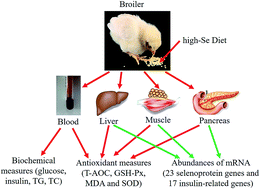Supranutritional dietary selenium induced hyperinsulinemia and dyslipidemia via affected expression of selenoprotein genes and insulin signal-related genes in broiler†
Abstract
The purpose of this study was to investigate the effects of supranutritional selenium (Se) on the mRNA expression of selenoprotein genes and insulin signal-related genes in the liver, muscle and pancreas of the broiler. A total of 160 one-day-old Cobb male broilers (n = 80 per group) were fed a Se-deficient corn–soybean basal diet supplemented with 0.3 (adequate), and 3.0 (excess) mg kg−1 sodium selenite for 6 weeks. Pancreas, liver and muscle were collected, and the effects of supranutritional Se on mRNA abundance of 23 selenoprotein genes and 17 insulin-related genes were compared at day 42. Also, enzyme activities and plasma biochemical measurements were measured at days 14, 28, and 42. The results showed that a high-Se diet depressed the growth performance of broilers and elevated (P < 0.05) the activities of superoxidase dismutase (SOD), total antioxidant capacity (T-AOC) and glutathione peroxidase (GSH-Px), mainly in the early stages. A high-Se diet up-regulated 12 selenoprotein genes in muscle, 7 genes in liver and Sephs2 in the pancreas, and down-regulated 3 selenoprotein genes in muscle, 4 genes in liver and 7 genes in the pancreas. Meanwhile, 4, 3 and 2 insulin signal-related genes were up-regulated in muscle, liver and the pancreas, respectively, 3 and 5 genes were down-regulated in muscle and the pancreas. Accompany the aberrant expression of selenoprotein and insulin signal-related genes, the birds exhibited a higher plasma insulin, total triglyceride (TG) and total cholesterol (TC) concentrations by high Se. In conclusion, the high Se diet induced hyperinsulinemia and dyslipidemia in birds via a mediating aberrant expression of selenoprotein genes associated with insulin signal-related genes, which indicated potential roles of those selenoprotein genes in the lipid and carbohydrate metabolism regulation in birds.


 Please wait while we load your content...
Please wait while we load your content...